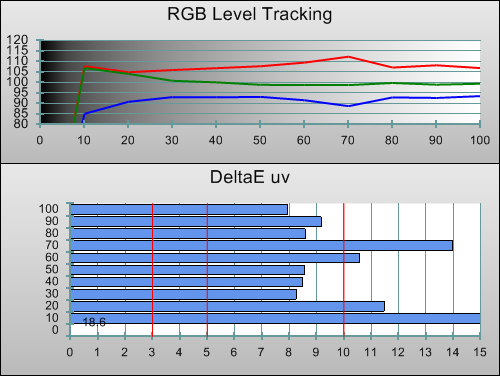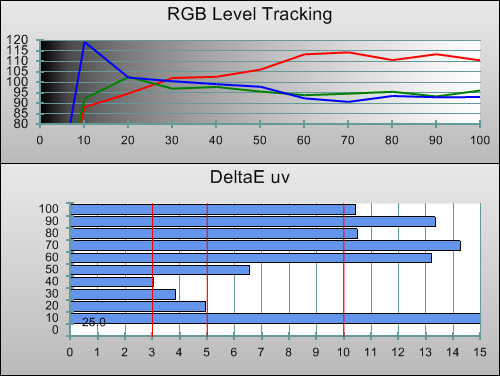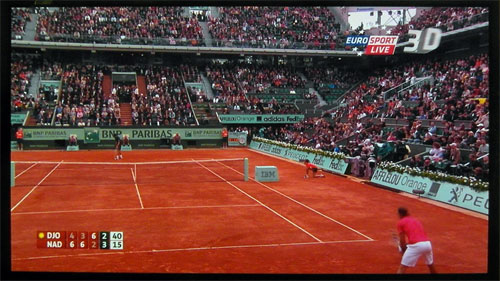The Panasonic Viera ST50 series is certainly shaping up to be the value-for-money performer within the Japanese manufacturer’s 2012 range of 3D-capable plasma TVs. Probably the most notable improvement on this year’s ST series is the inclusion of white balance (albeit only 2-point instead of the 10-point version reserved for the step-up GT50 and flagship VT50 series) and gamma controls, as well as a colour management system (CMS), all of which were not available on previous generations. Today we’re going to have a look at the 50-inch model, namely the Panasonic TX-P50ST50.
<!-- google_ad_client = 'pub-2887677957235196'; google_ad_slot = '4990177225'; google_ad_width = 336; google_ad_height = 280; //-->
Note: The specific unit we tested was the Panasonic TX-P50ST50B, which is the British 3-pin-plug version. Because we have done a comprehensive review of the smaller, 42-inch TX-P42ST50B some 3 months ago, this article is condensed, since many aspects (such as design, user menu, remote control, connections, internet connectivity and video processing) are identical between both screen sizes.
Note: Our Panasonic TX-P50ST50B review sample was calibrated using Calman Professional, the industry-leading video calibration software.
Among the picture presets available on the HDTV, [True Cinema] yielded the greyscale closest to D65 video and broadcast industry standard out of the box:
 |
| Pre-calibration RGB tracking and delta errors (dEs) |
As is the case with most [Cinema] or [Movie] picture modes offered on consumer-grade televisions, the image looked too warm due to an overcast of red. For the first time on a Panasonic ST plasma series, we can use the 2-point white balance controls found in the on-screen menu to rectify this, instead of having to wade into the service menu. Here’s the result:
![Post-calibration RGB Tracking in [True Cinema] mode](https://www.hdtvtest.co.uk/news/wp-content/uploads/2018/04/hdtv_Panasonic-TXP50ST50_post-rgb.png) |
| Post-calibration RGB tracking and dEs in [True Cinema] mode |
Delta errors (dEs) were reduced to below 4 (generally regarded as the perceptible limit for human eye) from 20% stimulus onwards. Had a 10-point white balance system been offered on the TX-P50ST50, we would probably have been able to iron out the kinks at 70% and 100% stimulus, but that may be asking too much of a TV at this price point.
![Gamma curve in [True Cinema] mode](https://www.hdtvtest.co.uk/news/wp-content/uploads/2018/04/hdtv_Panasonic-TXP50ST50_post-gamma.png) | |
| Gamma curve in [True Cinema] mode | Corresponding gamma tracking |
While experienced calibrators can use white balance controls to adjust gamma provided there’s enough headroom both ways, the inclusion of a gamma control is always appreciated, since one can lower or raise the gamma profile across the entire luminance range with a click on the remote. On our TX-P50ST50B sample, selecting a [Gamma] value of “2.4” – either by coincidence or by design – brought us closest to our gamma target of 2.4. Owing to the ABL (automatic brightness limiter) mechanism implemented on plasmas, gamma tracking on these displays is typically not as flat as what LCD TVs are capable of.
The Panasonic TX-P50ST50 features a user-accessible CMS (colour management system) – a first for the company’s Viera ST range of plasma televisions – which allows for manipulation of the three primary colours (red, green, blue) but not secondary ones (cyan, magenta, yellow). Employing the strategy outlined in our TX-P42ST50 review, we initially adjusted the [Colour] control to bring the luminance/brightness of secondary colours closer to high-definition Rec.709 specification, then used the CMS to minimise delta errors (dEs) on the primaries.
![Post-calibration CIE chart in [True Cinema] mode](https://www.hdtvtest.co.uk/news/wp-content/uploads/2018/04/hdtv_Panasonic-TXP50ST50_post-cie.jpg) |
| Post-calibration CIE chart with reference to HD Rec.709 |
![Post-calibration Luminance levels in [True Cinema] mode](https://www.hdtvtest.co.uk/news/wp-content/uploads/2018/04/hdtv_Panasonic-TXP50ST50_post-colour-lum.png) |
| Post-calibration colour luminance (coloured bars = targets; black bars = measured values) |
We managed to calibrate the hue, saturation and luminance of red, green and blue to near-reference levels on the Viera TX-P50ST50B. Panasonic’s three-axis system compares favourably with CMS implementations on rival TV brands: Samsung’s version does offer secondary colour adjustments but is less intuitive; Toshiba’s colour luminance control has historically been problematic; and Sony does not provide any colour management system beyond the basic [Colour] and [Tint] controls even on its high-end Bravia HDTVs.
This is the first time we are tracking colour saturation levels on the Panasonic ST50, since we did not have access to Calman 5 (the latest version of the calibration software we use that offers this measurement) when we tested the 42ST50.
| Post-calibration colour saturation tracking |
The TX-P50ST50 did extremely well in this regard. Blue saturates too quickly at 25%, 50% and 75% intervals, but this shouldn’t be an issue in real-life viewing, as the human eye is less sensitive to blue frequencies compared to red and green.
Calibration in 3D mode is still shunned by most technical publications, due to the specialised instruments, test patterns, expertise and time required. This is unfortunate, because seeing accurate colours in extra-dimensional content is every bit as rewarding as it is in 2D. Soldiering on, we attached a pair of Panasonic TY-ER3D4ME active-shutter 3D glasses (needs to be purchased separately) to our light meter, and measured away:
 |
| 3D Pre-calibration RGB tracking and delta errors (dEs) |
Out of the box, [True Cinema] again remains the best option for owners who do not have the means to calibrate their Panasonic TX-P50ST50B in 3D mode. However, on our pre-calibration run we detected too much blue on the low-end but a predominance of red over the rest of the luminance range, which would present a mixed tri-dimensional viewing experience for users.
![3D Post-calibration RGB Tracking in [True Cinema] mode](https://www.hdtvtest.co.uk/news/wp-content/uploads/2018/04/hdtv_Panasonic-TXP50ST50_3d-post-rgb.png) |
| 3D Post-calibration RGB tracking and dEs in [True Cinema] mode |
Our calibration improved things greatly, although there were still some untameable inaccuracies most notably around 60-70% stimulus, which was unavoidable given the inherent limitations within a 2-point white balance control system.
Moving onto colours in the third dimension, Panasonic’s CMS allowed us to at least bring the luminance and hue of RGB primary colours within specification. Tried as we might, we failed to fully saturate blue primary as seen through the 3D eyewear, a seemingly common finding on the Japanese TV maker’s 3D plasmas.
![3D Post-calibration CIE chart in [True Cinema] mode](https://www.hdtvtest.co.uk/news/wp-content/uploads/2018/04/hdtv_Panasonic-TXP50ST50_3d-post-cie.jpg) |
| 3D Post-calibration CIE chart with reference to HD Rec.709 |
![3D Post-calibration Luminance levels in [True Cinema] mode](https://www.hdtvtest.co.uk/news/wp-content/uploads/2018/04/hdtv_Panasonic-TXP50ST50_3d-post-colour-lum.png) |
| 3D Post-calibration colour luminance (coloured bars = targets; black bars = measured values) |
| Dead pixels | None |
| Screen uniformity | Excellent |
| Overscanning on HDMI | 0% with [16:9 Overscan] set to “Off“ |
| Blacker than black | Passed |
| Calibrated black level (black screen) | 0.0083 cd/m2 |
| Calibrated black level (ANSI checkerboard) | 0.0109 cd/m2 |
| Black level retention | Stable |
| Primary chromaticity | Excellent |
| Scaling | Very good |
| Video mode deinterlacing | Very effective jaggies reduction |
| Film mode deinterlacing | Passed 3:2 cadence in 480i and 1080i, and 2:2 in 576i |
| Viewing angle | Excellent |
| Motion resolution | 1080 even with [Intelligent Frame Creation] and [24p Smooth Film] off |
| Digital noise reduction | Acceptable at baseline |
| Sharpness | Defeatable edge enhancement |
| Image retention | Very few instances, which are quickly cleared |
| Posterization | Mild, though worse with poor source |
| Phosphor trails | Mild, though severity depends on individual susceptibility |
| 1080p/24 capability | No judder in 2D nor 3D |
| Input lag | 16ms compared to lag-free CRT |
| Default [Normal] mode (2D) | 114 watts |
| Default [Normal] mode (3D) | 174 watts |
| Calibrated [True Cinema] mode (2D) | 162 watts |
| Calibrated [True Cinema] mode (3D) | 223 watts |
| Standby | <1 watt |
Measurements taken with full 50% grey screen.
The Panasonic TX-P50ST50 delivers in spades 2D-wise. Never before has a flat-panel display with such deep blacks (only surpassed by the legendary and long-discontinued Pioneer Kuro plasmas) and such accurate colours been available at this screen size, and at this price point (around £1,000 at this time of writing).
High-def materials, be them Blu-ray movies or digital terrestrial television broadcasts from Freeview HD, are a joy to behold on the ST50. The few instances of “double fuzzy images” in 50hz or 60hz video material can be effectively suppressed by engaging [Intelligent Frame Creation] – we preferred the “Min” setting which introduced virtually no motion interpolation artefacts. The TV is no slouch at handling standard-definition content either, thanks to its impressive SD video processing.
One issue that may irk viewers who are not used to plasma displays is dynamic false contouring. Panasonic plasmas have traditionally had the tendency to depict what should be smooth gradients on moving objects as more sudden “steps”, and the TX-P50ST50B is no exception. The “Hammock” scene in the FPD Benchmark test disc demonstrated this perfectly: as the girl swung side to side, the skin tone on her right arm and face got broken up into distinct bands, when it should have transitioned smoothly from light to dark.
This phenomenon cropped up in various broadcast material too, which can be jarring to the uninitiated. We don’t think that it is a deal-breaker given the set’s strength in other aspects, but for those who cannot tolerate this artefact, Samsung plasma TVs may be a better choice.
When it comes to 3D, by far the biggest Achilles’ heel on the 50ST50 is the dimness of the image as seen through the active-shutter glasses. The highest luminance we managed to coax out of the 3DTV – we even tried using its [Dynamic] mode and setting [Contrast] to maximum at the expense of white headroom – was a dismal 26 cd/m2 (yes, that’s cd/m2, not fL) as measured through the right (or left) lense of the 3D glasses. For the record, after calibrating our TX-P50ST50 sample in 3D mode, top-end luminance was 23 cd/m2 without needing to clip whites nor sacrifice greyscale and colour accuracy.

What does this mean in practical terms? To fully enjoy extra-dimensional content on the Panasonic TX-P50ST50B, you really need to do it in near-total darkness. Yet there are occasions when this is simply not possible, for example when watching live 3D broadcasts of football or tennis matches which more often than not take place during the daytime. When we tuned into the Roland Garros 2012 final between Nadal and Djokovic on Sky 3D, we found that the ST50 just couldn’t muster enough brightness to overcome the invasion of sunlight into our viewing environment even with all the curtains drawn, therefore depriving 3-D images of contrast and depth. This is an area where LCD-based 3D TVs (especially passive ones) reign superior.
However, time your extra-dimensional viewing correctly (read: watch your 3D Blu-ray films at night!), and you’ll be rewarded with a wonderfully captivating experience that is heavy on multi-layered depth and light on crosstalk. The TX-P50ST50 didn’t skip a beat in presenting all the 3D content (50Hz, 60Hz or 24p) thrown at it with nary a hint of judder, as long as [3D Refresh Rate] was set to “Auto“.
We have spent some paragraphs describing certain shortcomings on the ST50, but we could probably have written twice as many extolling the numerous virtues of the 3D plasma TV. The bottom line is, the Panasonic TX-P50ST50B is a competitively-priced HDTV that will appeal greatly to movie lovers, sports fans and video gamers, thanks to its near-reference greyscale and colour accuracy, outstanding motion performance, as well as excellent gaming responsiveness.
